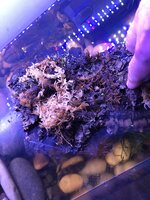I let my salamanders 'dry out' for a bit, meaning their tank has little to no water only the moisture on them and from the substrate/natural moss, (sometimes I use a cut material, flannel, jersey cotton, pieces of an old pillow case [big enough to cover their head and most of their body] usually only for med/quartine tubs, to transfer if/when sick)
Also, your newts should be in a hibernating state during winter, like all other frogs, snakes and amphibians, which live in and across Canada, which means you could have too much water in the tank, if they are still active and eating they could be confused on the season.
I try to mimic the outside climate around my location inside my house/tank as much as possible, so my salamanders have actually been hibernating since mid-November, in two separate areas of my ten gallon tank with only moist substrate/natural moss and a heat lamp that is timed for the natural sunrise/sunsets in my location.
I also keep my tank temperature at the lowest my aquatic reptiles can handle which is 15 degrees Celsius.
In the wild they would be hibernating around damp Forrest floors leaf litter, bottoms of ponds, where they can tolerate very low oxygen levels but will survive only a few days if the pond becomes completely de-oxygenated.
I have a side dish(their empty food-dish) that I add fresh water too every three or four days(when I notice it's dry) and the way my tank is set up the added water falls down like a waterfall adding more oxygen into the substrate that they have been hiding in, they'll come out in spring to mate, right before they went into hibernation they ate everyday on two week diet of waxworms, they haven't eaten since, and it did fatten them up and if I do have a meal ready for when they emerge from their dens they might not eat other.
Once my duo are active again, I strip my whole tank for their spring cleaning,(which I do twice a year) plus mine have finally reached reproduction maturity and will be mating this year, and as soon as they do, they will have to be removed for the young... My little one already trys to eat my big one, not to bright but cute, I have them on the same feeding schedule but have to separate them in two completely different enclosures from time to time.
I will take one in the morning for sure. The more I read they actually are probably in the Terrestrial Eft stage. they are pretty little. Considering just removing the large amount of water and redoing the setup for terrestrial until they show interest in being aquatic.

